Provision users and groups with Okta (SCIM)
System for Cross-Domain Identity Management (SCIM) is an open standard protocol for the automation of user provisioning.
Automatic provisioning refers to creating users and user groups in Harness. In addition to creating these, automatic provisioning includes the maintenance and removal of users and user groups as and when required.
This topic describes how to build a SCIM endpoint using OKTA and integrate it with Harness.
Before you begin
- This topic assumes you understand System for Cross-domain Identity Management (SCIM). For an overview, see the article Introduction to System for Cross-domain Identity Management (SCIM).
- Learn Harness' Key Concepts
- Access Management (RBAC) Overview
- Make sure you are an Administrator in your Okta account and have the Account Admin permissions in Harness.
- Make sure you have a Harness API Key and a valid Token under it. The API Key must have all permissions on the Users and User Groups.
Review: Harness Okta SCIM integration
By using Okta as your identity provider, you can efficiently provision and manage users in your Harness Account, Org and Project. Harness' SCIM integration enables Okta to serve as a single identity manager, for adding and removing users, and for provisioning User Groups. This is especially efficient for managing many users.
In exchange for the convenience of Okta-provisioned users and groups, you must configure several aspects of Okta, as described in the following sections. You will also have restrictions on modifying Okta-provisioned users and groups natively within Harness, as described in Limitations.
Supported features
Once you have set up the SCIM integration between Okta and Harness (as described below), Administrators will be able to perform the following Harness actions within Okta:
- Create users, individually, in your Harness app.
- Assign Okta-defined groups to your Harness app.
- Group push already-assigned groups to Harness.
- Update User Attributes from Okta to Harness.
- Deactivate Users in Okta and Harness.
Limitations
When you provision Harness User Groups and users from Okta, you will not be able to modify some of their attributes in Harness Manager. You must do so in Okta.
Operations that you cannot perform on Okta-provisioned User Groups within Harness Manager are:
- Managing users within the User Group.
- Adding users to the User Group.
- Removing users from the User Group.
- Renaming the User Group.
- Deleting the User Group.
If a User Group provisioned from Okta duplicates the name of an existing Harness User Group, Harness will maintain both groups. To prevent confusion, you are free to rename the native User Group (but not the Okta-provisioned group).
Where a User Group has been provisioned from Okta, you cannot use Harness Manager to edit the member users' details (Email Address, Full Name, or User Groups assignments).
You must use Okta to assign these users to other User Groups (to grant corresponding permissions). You must also use Okta to delete these users from Harness, by removing them from the corresponding Okta app.
When you use Okta to directly assign users to Harness, those users initially have no User Group assignments in Harness. With this method, you are free to use Harness Manager to add and modify User Group assignments.
Step 1: Create app integration in Okta
To automate the provisioning of users and groups, you must add a Harness app to your Okta administrator account. To do that perform the following steps
Log in to your Okta administrator account and click Applications.
Click Create App Integration.

The Create a new app integration dialogue appears. Select SAML 2.0 and click Next.
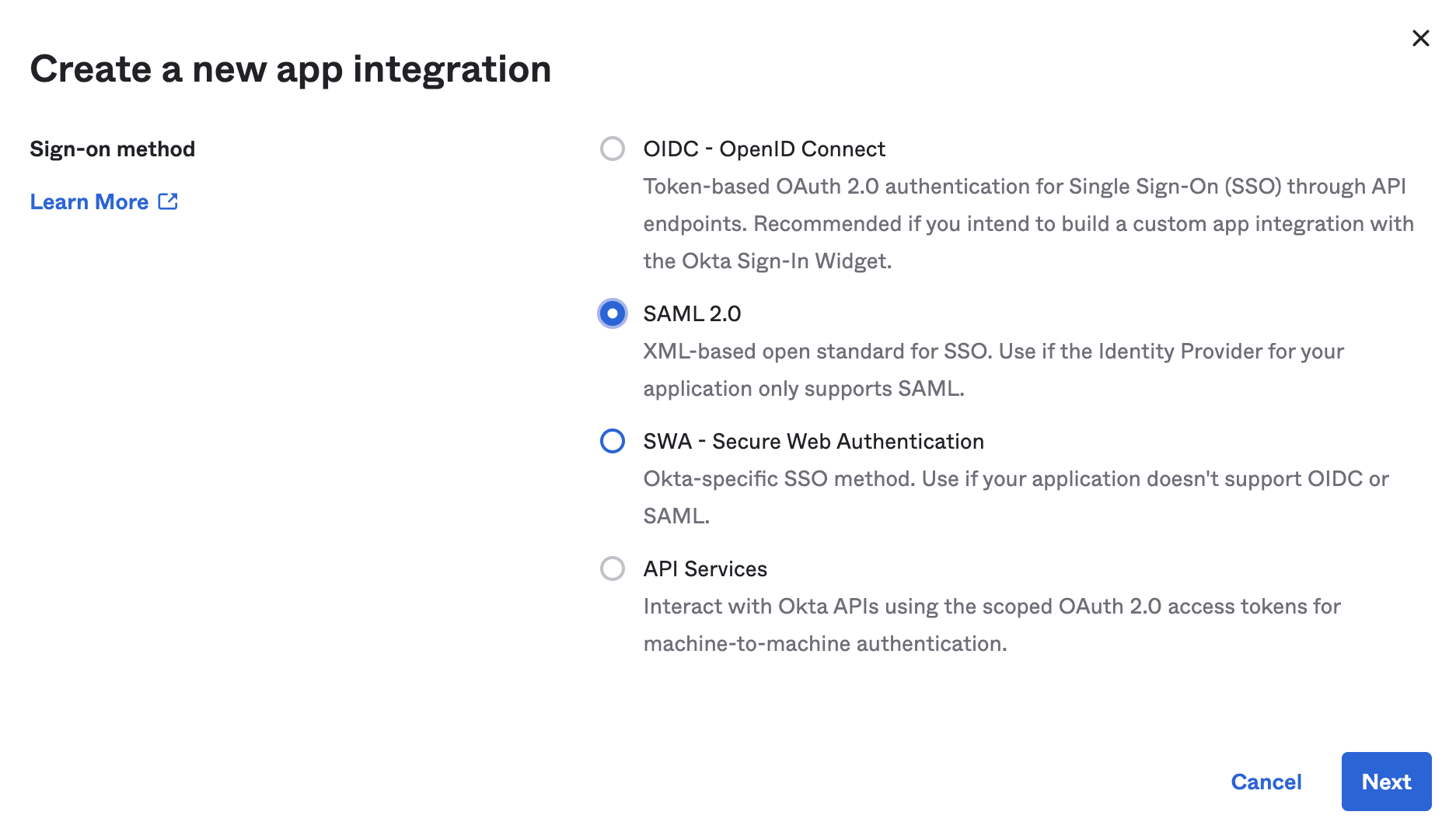
In General Settings, enter a name in the Application label field, and click Next.
The SAML settings appear.
Enter your Single sign on URL. To get the Single sign on URL, add your account ID to the end of the following
URL: https://app.harness.io/gateway/api/users/saml-login?accountId=
In Audience URI (SP Entity ID), enter app.harness.io.
In Attribute Statements (optional), enter name in the Name field, select Name Format as Basic, and select the Value as user.email.
In Group Attribute Statements (optional), enter a name in the Name field, select Name format (optional) as Basic, select an appropriate Filter, and enter its value.
Click Next.
The Feedback options appear. Select option and click Finish.
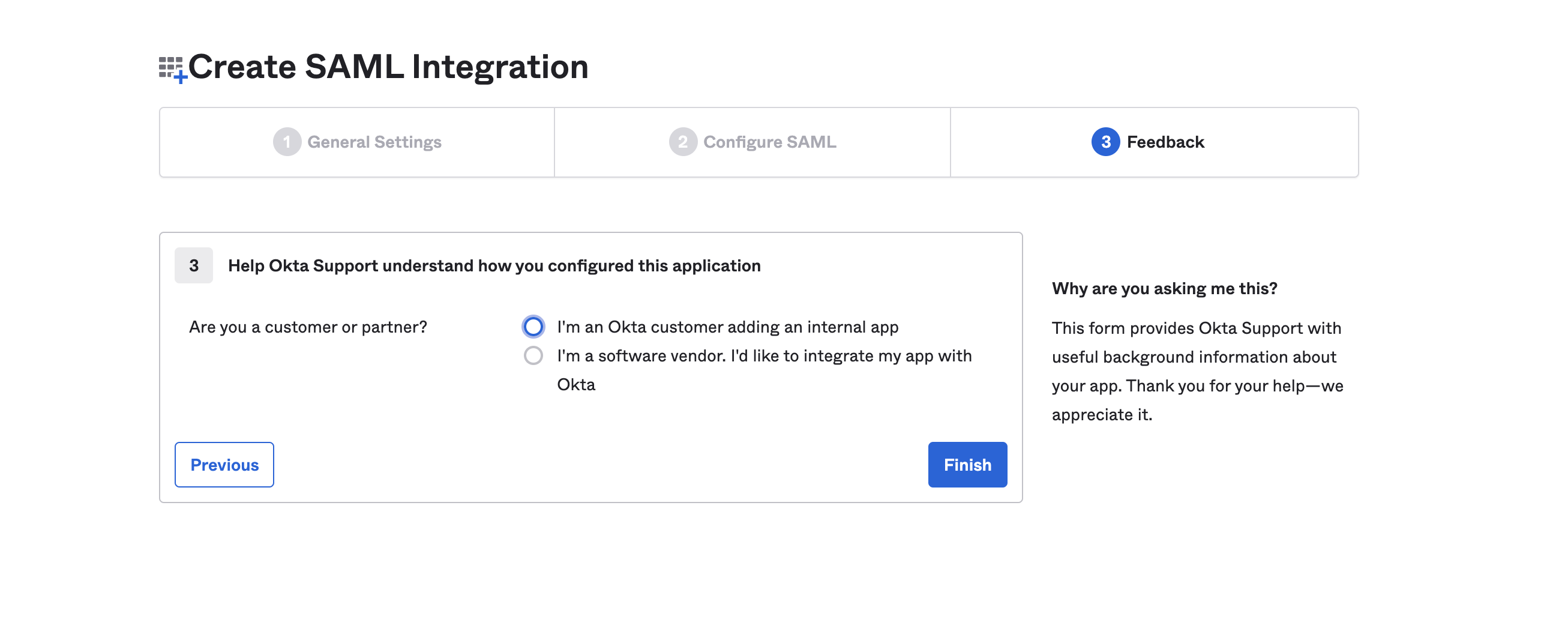 Click General and then click Edit in App Settings.
Click General and then click Edit in App Settings.
Select Enable SCIM provisioning in Provisioning. Click Save.
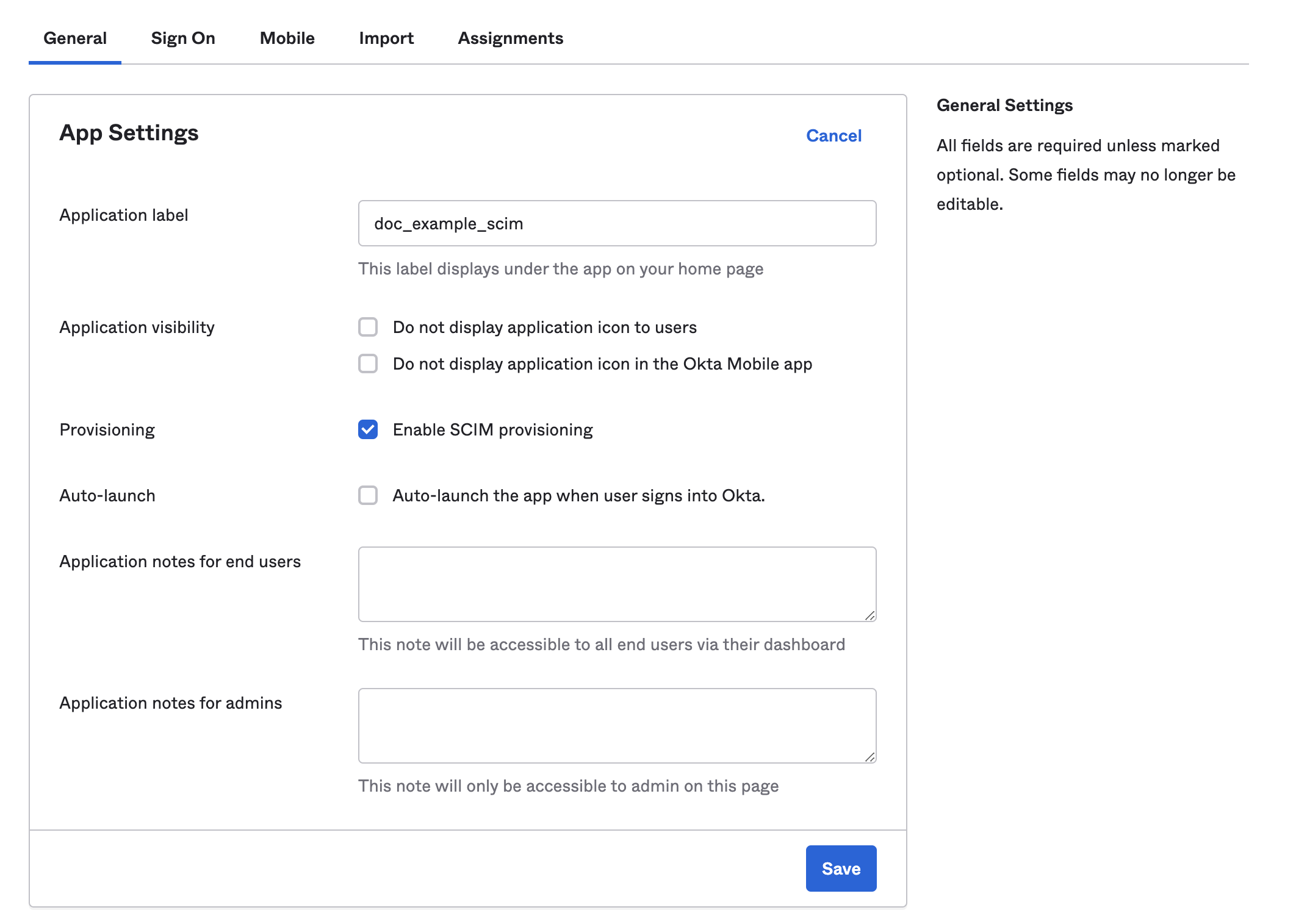
Step 2: Authorize Okta integration
In your Okta administrator account and click Applications > Applications.
Search your Application.
Click Provisioning and then click Integration.
Click Edit.
In SCIM connector base URL enter the Base URL for your API endpoint.
To get the SCIM connector base URL, add your account ID to the end of the following
URL: https://app.harness.io/gateway/ng/api/scim/account/<your_account_id>
Enter userName in Unique identifier field for users and select Supported provisioning actions.
Select Authentication Mode as HTTP Header and enter your API Token in Bearer.
For information on how to create an API Token in Harness, see Add and Manage API Keys.
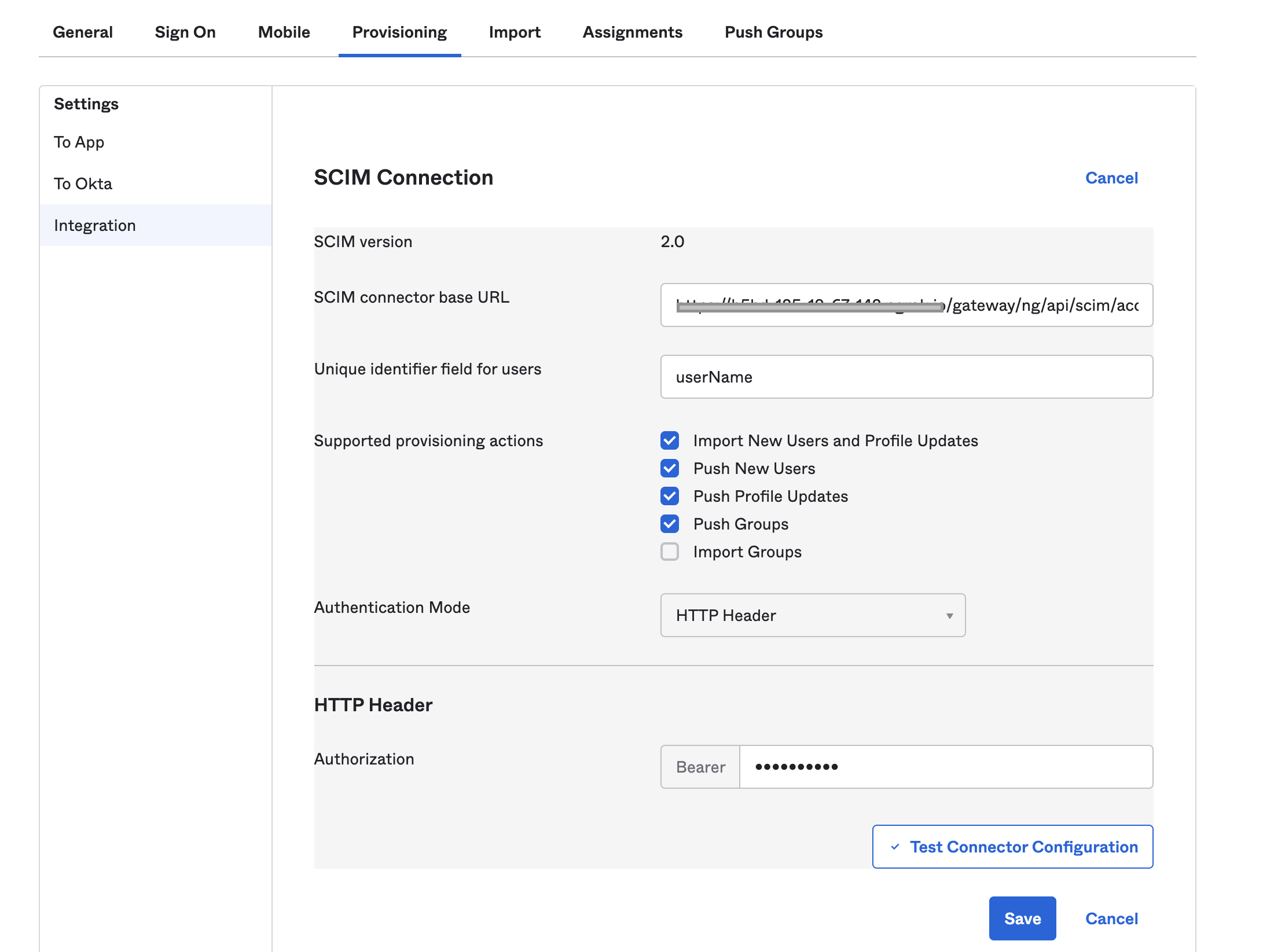 Click Test Connection and then Save after the test is successful.
Click Test Connection and then Save after the test is successful.
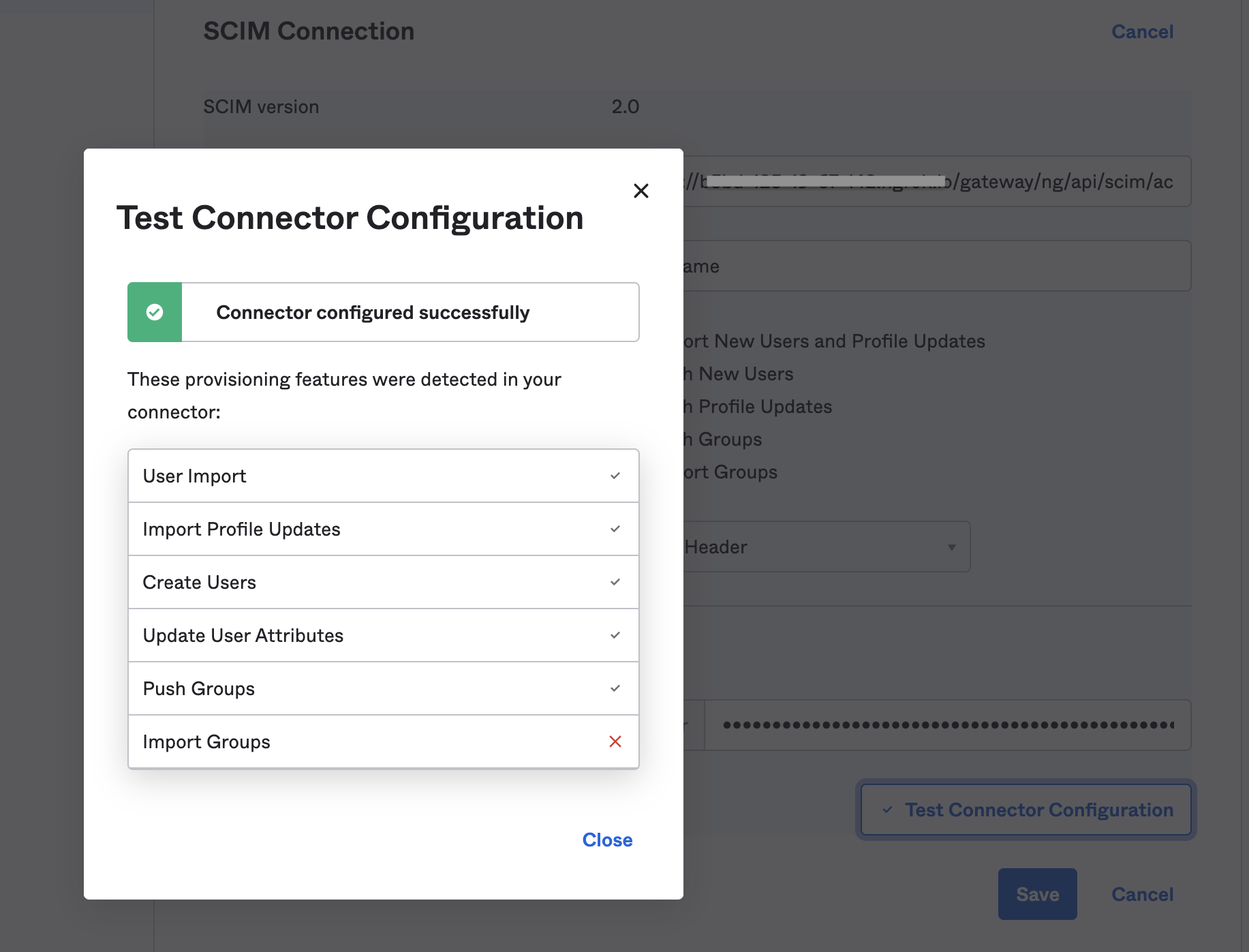 Your Okta app is now authorized with Harness.
Your Okta app is now authorized with Harness.
Next, click To App settings in Provisioning and enable Create Users, Update User Attributes and Deactivate Users.
 Click Save.
Click Save.
Option: Create users
To directly assign your Harness app to individual (existing) Okta users, thereby provisioning the users in your Harness Account perform the following steps:
In your Okta application, click Assignments.
Click People.
Click Assign > Assign to People. The Assignments settings appear.
Select users and click Assign.
Click Save and Go Back.
Click Done after you have assigned all the intended users.
Users with the Harness app assignment now appear in People.
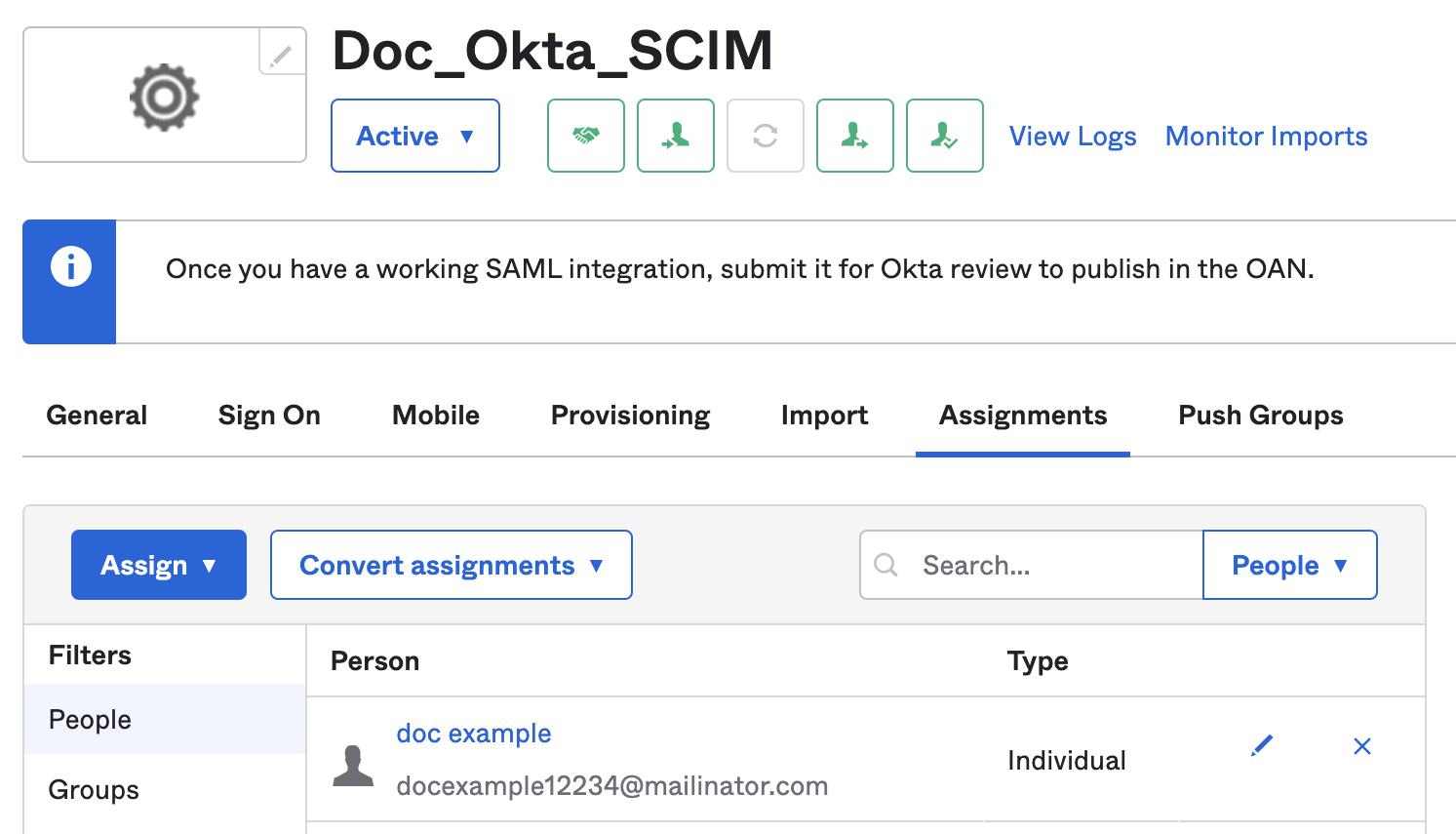 You can edit or delete users from here.
You can edit or delete users from here.
The user is now listed in your Harness account.

Option: Assign groups
To assign the Harness app to Okta-defined groups of users, perform the following steps:
In your Okta application, click Assignments.
Click Groups.
Click Assign > Assign to Groups. The Assignments settings appear.
Select groups and click Assign.
Click Save and Go Back.
Click Done after you have assigned all the intended groups.
Groups with the Harness app assignment now appear in Groups.
You can edit or delete users from here.
Push assigned groups to Harness
To provision your application's assigned groups in Harness:
Click Push Groups in your application, then select Push Groups > Find Groups by Name.
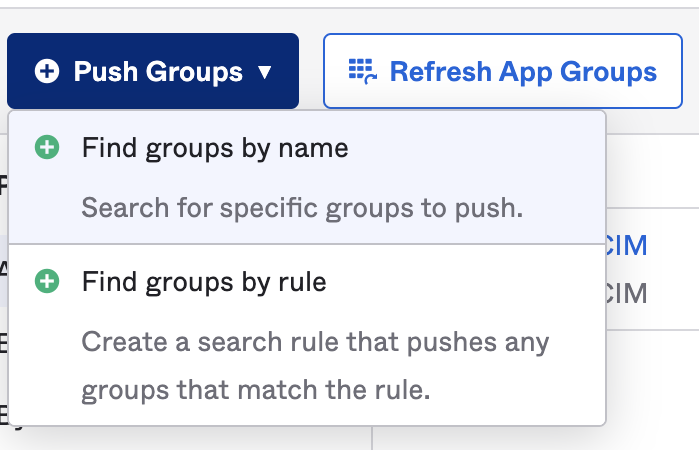
Search for the group(s) you want to provision.
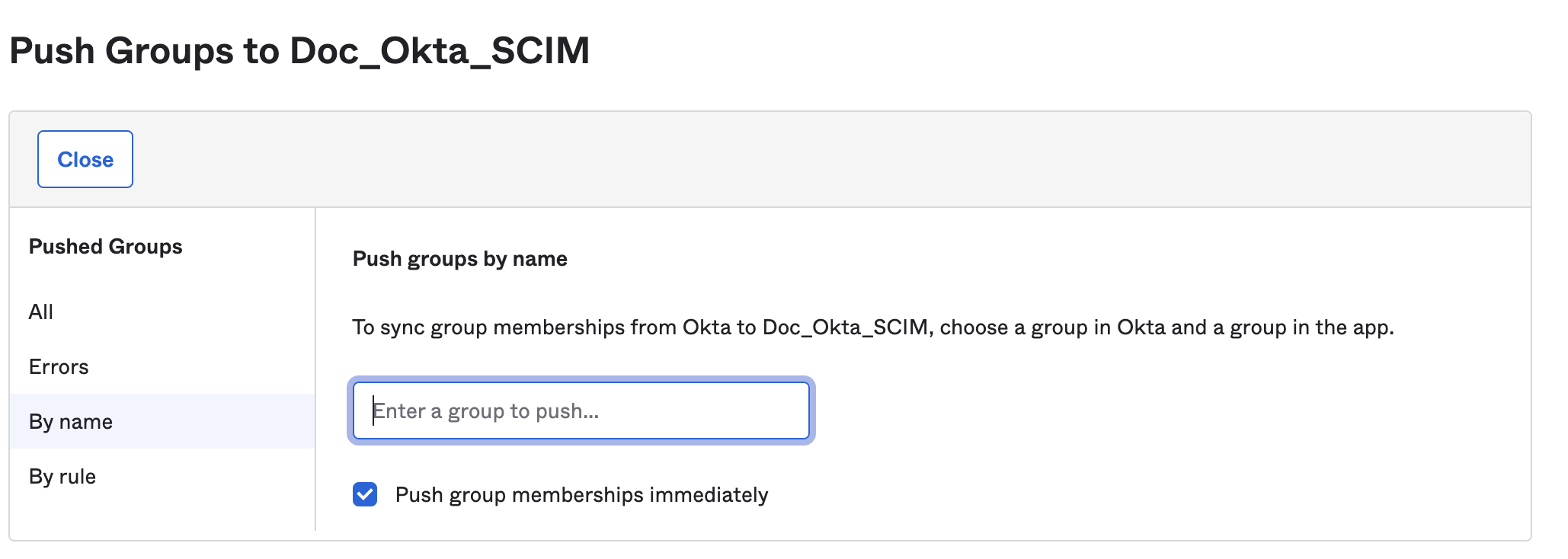
Click Save. You can see the status of this Push Group in your application.
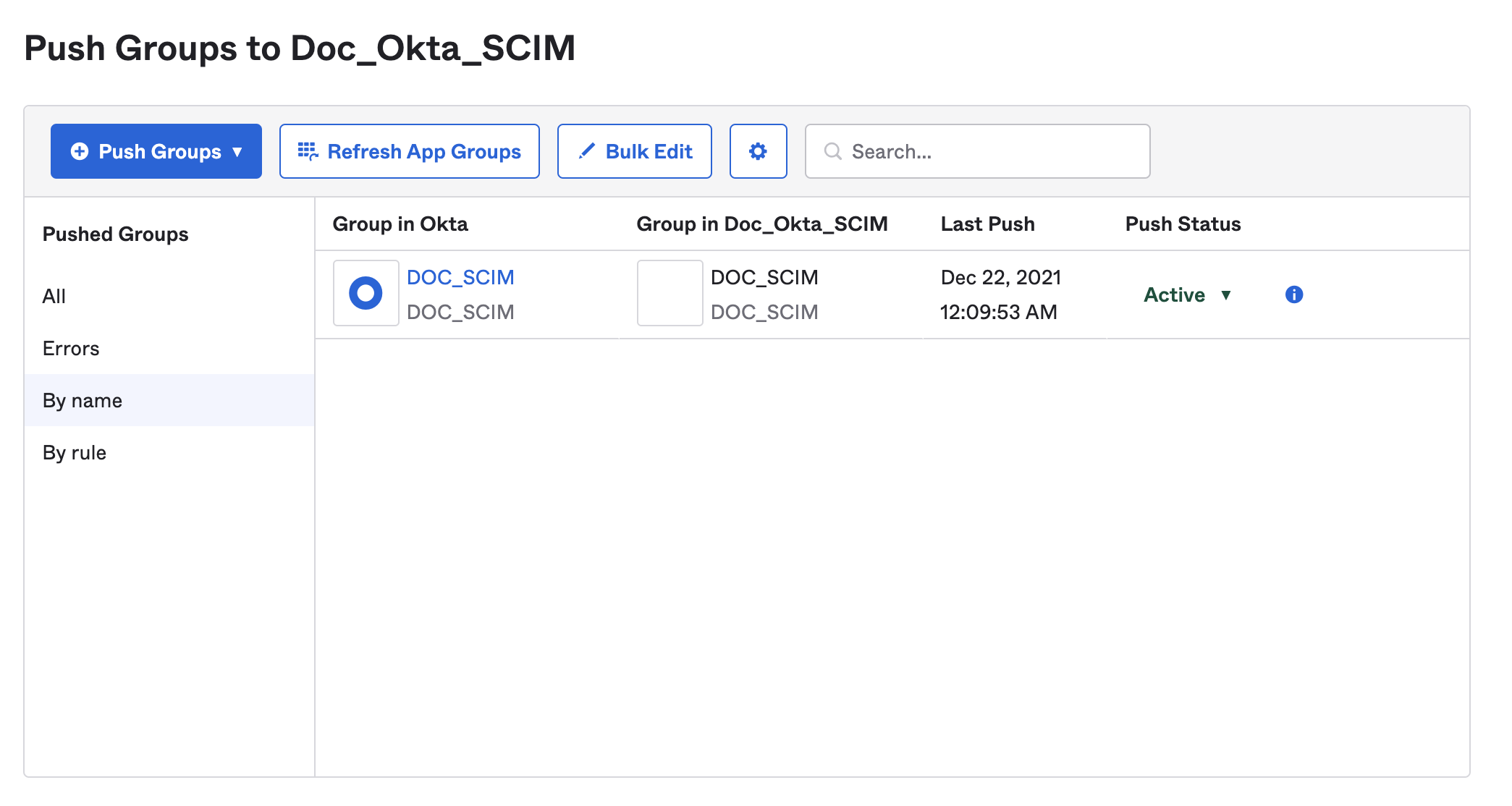
If an error prevents adding, deleting, or updating an individual user to Harness, you must retry provisioning the user later, after resolving the issues. For more information, see Troubleshooting Group Push.
This group is now listed in your Harness account.
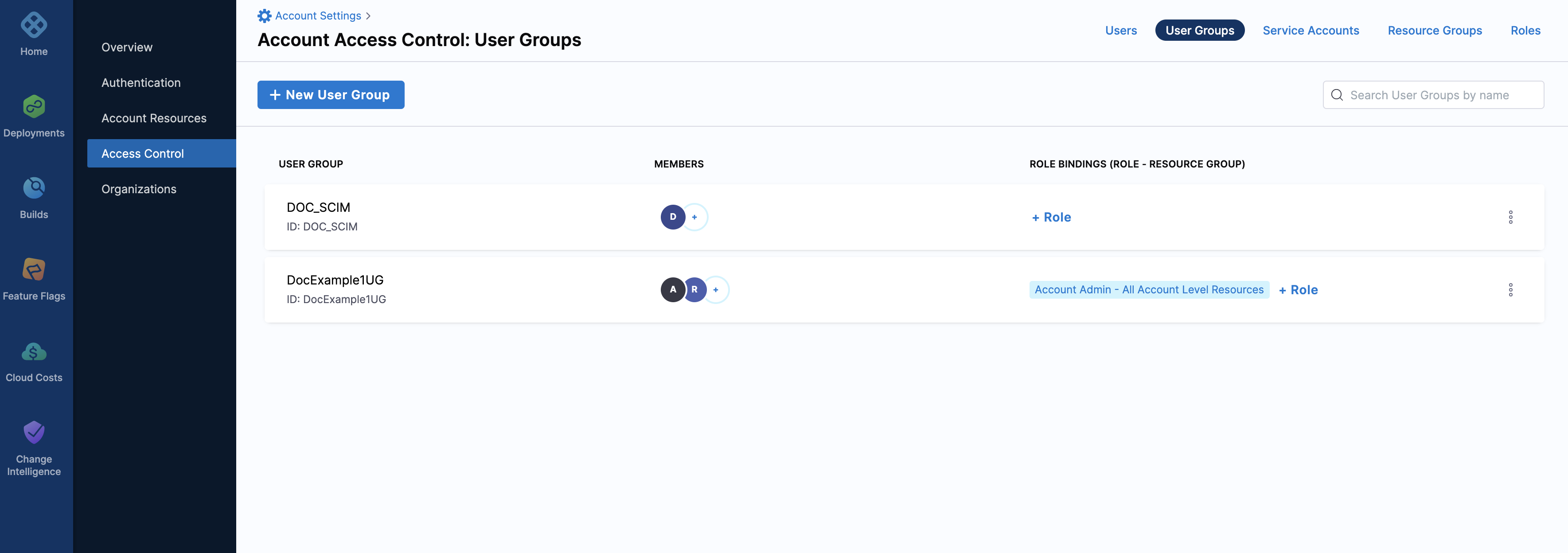
When provisioning user groups through SCIM, Harness replaces any .,-, or a space in your user group name and uses it as the group identifier. For example, if your group name is example-group in your SCIM provider, its identifier in Harness would be example_group.
Option: Update user attributes
You can edit a user's profile in Okta to update the following attribute values for the corresponding user in Harness:
- Given name
- Family name
- Primary email
- Primary email type
- Display name
To update user attributes:
- From your Okta administrator account, select Directory > People.
- Locate the user you want to edit, and click their name to display their profile.
- Click the Profile tab, then click the Edit button.
- Update the desired attributes, then click Save.
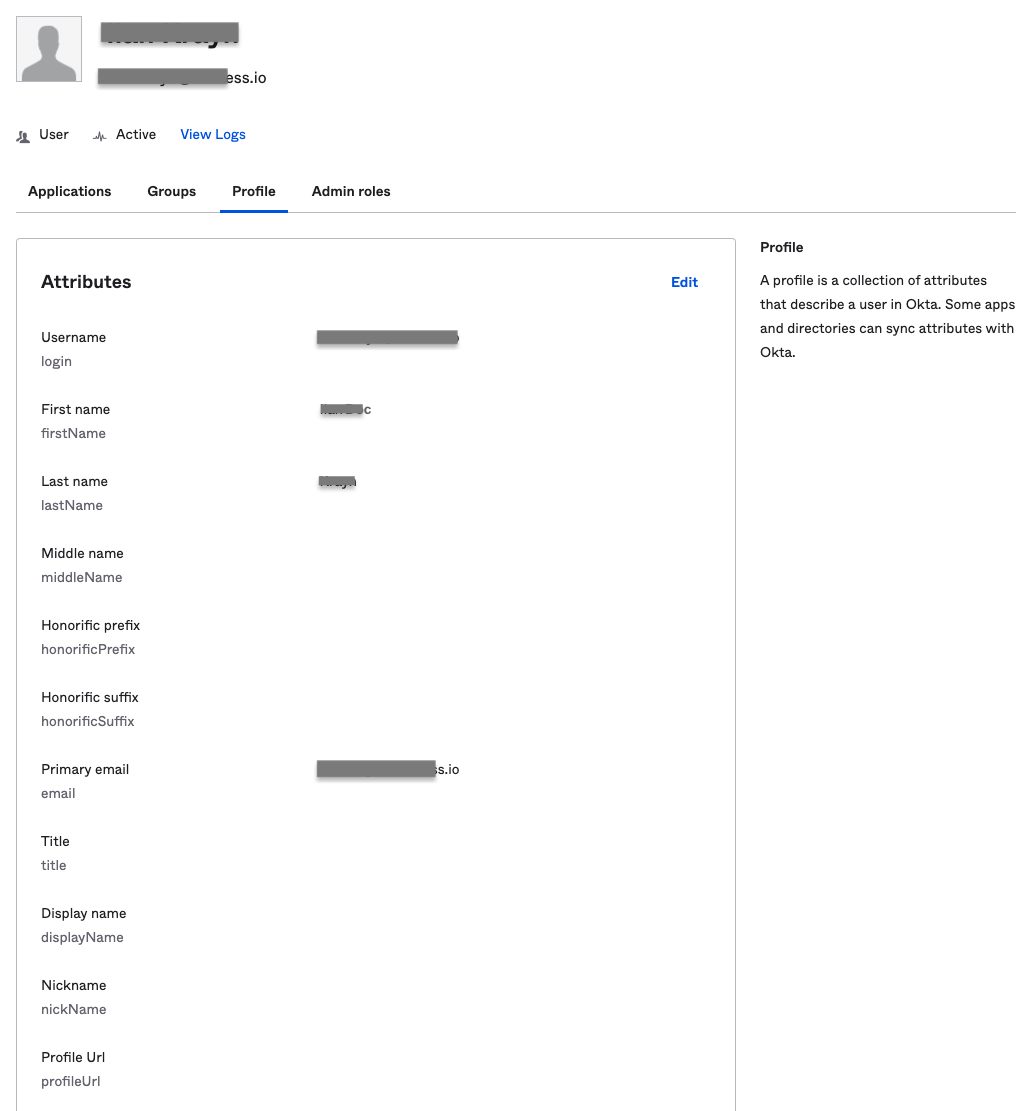
Only the five fields listed at the top of this section are synced to Harness users. You can update values in other fields, but those values are saved for this user in Okta only and are not updated in Harness.
The Display name in Okta is displayed as the user name in Harness.
Deactivate users
You can deactivate users in Okta to delete their Harness accounts, as follows:
- From Okta's top menu, select Directory > People, then navigate to the user you want to deactivate.
- From that user's profile, select More Actions > Deactivate.
- Click Deactivate in the resulting confirmation dialog.
Deactivating a user removes them from all their provisioned apps, including Harness. While a user account is deactivated, you cannot make changes to it. However, as shown below, you can reactivate users by clicking Activate on their profile page.
What if I already have app integration for Harness FirstGen?
If you currently have a Harness FirstGen App Integration setup in your IDP and are now trying to set up one for Harness NextGen, make sure the user information is also included in the FirstGen App Integration before attempting to log into Harness NextGen through SSO.
Harness authenticates users using either the FirstGen App Integration or the NextGen App Integration. If you have set up both, Harness continues to use your existing App Integration in FirstGen to authenticate users that attempt to log in using SSO.
Let us look at the following example:
- An App Integration is already set up for FirstGen with 2 users as members:
user1@example.comanduser2@example.com. - Now you set up a separate App Integration for Harness NextGen and add
user1@example.comanduser_2@example.comas the members. - You provision these users to Harness NextGen through SCIM.
user1@example.comanduser_2@example.comtry to log in to Harness NextGen through SSO.- The FirstGen App Integration is used for user authentication.
user1@example.comis a member of the FirstGen App Integration and hence is authenticated and successfully logged in to Harness NextGen.user_2@example.comis not a member of the FirstGen App Integration, hence the authentication fails and the user cannot log in to Harness NextGen.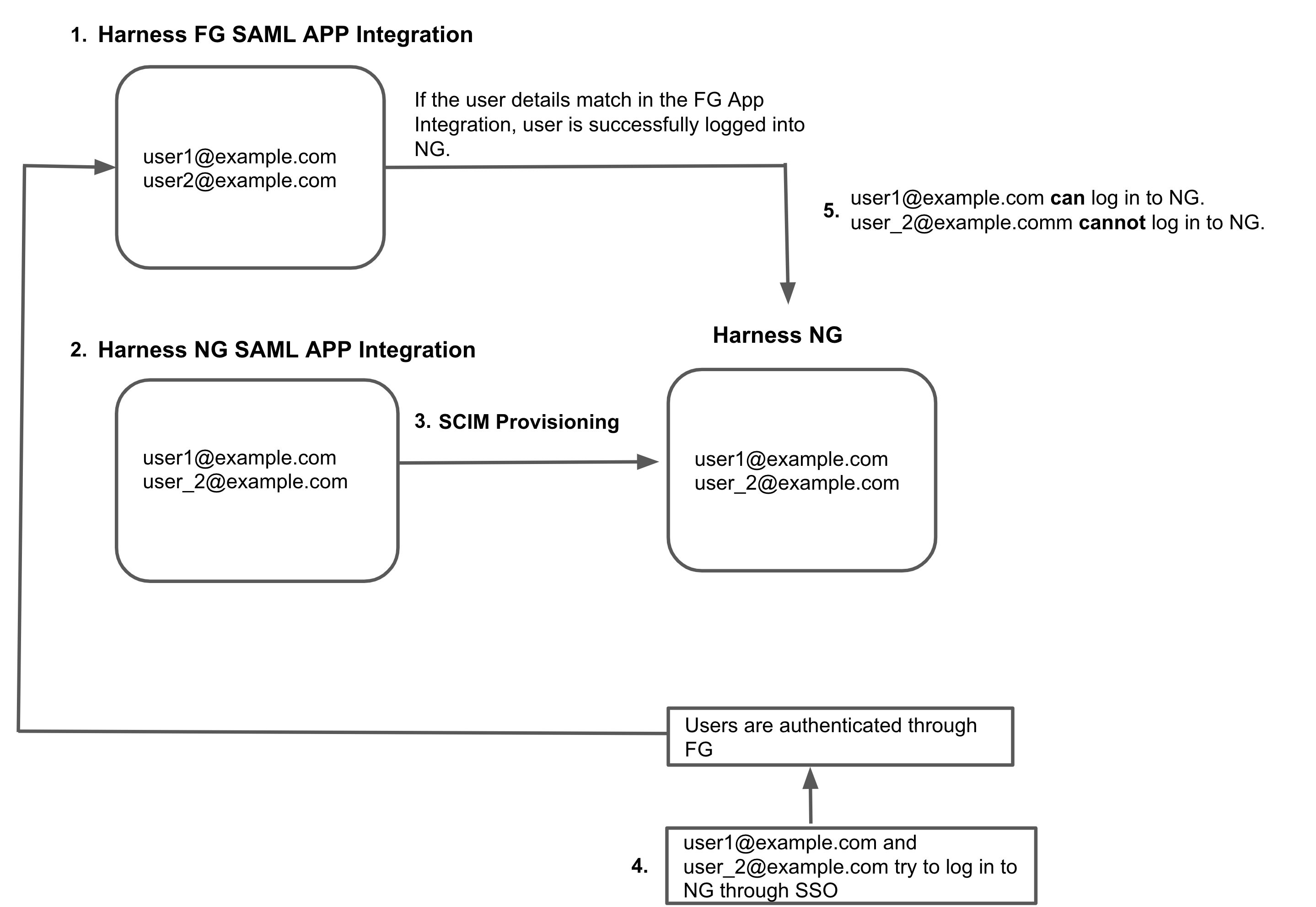
Assigning permissions post-provisioning
Permissions can be assigned manually or via the Harness API: